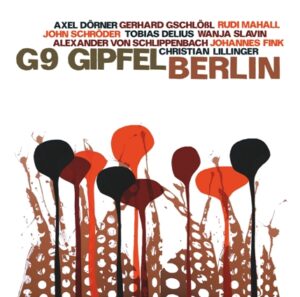CD jw 080 G9 GIPFEL: BERLIN
GERHARD GSCHLÖSSL trombone
AXEL DÖRNER trumpet
WANJA SLAVIN alto saxophone
TOBIAS DELIUS tenor saxophone
RUDI MAHALL bass clarine
JOHN SCHRÖDER guitar
ALEXANDER VON SCHLIPPENBACH piano
JOHANNES FINK double bass
CHRISTIAN LILLINGER drums
Recorded August 5 & 6, 2009
DEU
BERLINER GIPFELSTURM Gipfel nennt man sowohl den höchsten Punkt innerhalb einer gewissen Umgebung wie auch eine Konferenz führender Leute. Beides trifft hier zu. „Nur des Lebens Gipfel … zündet Neues“, schrieb Schiller, wenn man es klassisch haben will. Wichtig ist, dass man nach einer Ankunft den nächsten Weg nicht aus dem Blick verliert. „Sei so viel du kannst, Mann“, dekretierte Charles Mingus. Wichtig ist auch, dass gerade in unwegsamem Gelände mancher Gipfel noch nicht vermessen ist. Das hat etwas unbedingt Reizvolles. Insofern sind wir hier Zeugen einer abenteuerlichen Expedition ins Ungesicherte. Die sich dorthin aufmachten, sind tatsächlich die Besten einer Szene. Es ist Gschlößls Wunschbesetzung und als er einlud, gab es keine Absagen. „Ich sehe ein paar Wege und versuche, die weiterzuentwickeln“, fasst er zusammen. Wenn er seine Mitspieler beschreibt, sagt er immer wieder Vokabeln wie eigenständig, individuell, intensiv, unglaublich. Für eigentlich alle gilt: „Ich kenne keinen, der so spielt wie er. Er spielt nicht nur die Noten, die auf dem Blatt stehen, sondern macht mehr daraus.“ Vor allem aber gilt, dass dies alles in der Summe mehr ergibt als die Addition der einzelnen Teile. Dies ist ein Gipfelsturm, der die diversen Erfahrungen aller zu etwas Größerem aufbrechen lässt. Nichts ist hier kosmetisch glattpoliert oder ambitioniert überzogen, was bei Bands dieser Größe gerne der Fall ist. „Es ist durchaus nicht angestrebt, perfekt zu spielen. Davon lebt es. Auch von den falschen Tönen an den richtigen Stellen“, beschreibt das Gschlößl. Diese Musik ist glaubhaft, weil sie mit Ecken und Kanten daherkommt, weil sie den Schmutz, der zum Leben gehört, nicht verbirgt. Das ist weder strenger Mainstream noch pure Avantgarde. Man hört das Woher und ahnt ein Wohin. Ulrich Steinmetzger
ENG
Taking advantage of the multiplicity of colors, as well as the flexibility available from nine balanced instruments, trombonist Gerhard Gschlössl demonstrates his skills as a composer and arranger with this significant CD. Providing nourishment from all orchestral food groups – brass, reeds and strings – the layered performances are lively and cohesive as well as offering ample solo space. Besides the Stuttgart-born, Berlin based Gschlössl – who self-effacingly avoids the making the 10 compositions mere trombone showcases – the rest of the band is composed of many of the German capital’s most accomplished players who often work together in interlocking ensembles. For instance bass clarinetist Rudi Mahall, bassist Johannes Fink and drummer Christian Lillinger are members of Vierergupper Gschlössl with the trombonist. Mahall, trumpeter Axel Dörner and pianist Alexander von Schlippenbach make up Monk’s Casino. Guitarist John Schröder is in Der Rote Bereich with Mahall, while alto saxophonist Wanja Slavin’s band features Lillinger. Tenor saxophonist Tobias Delius leads his own bands and is part of Amsterdam’s ICP Orchestra. On the evidence here, G9 Gipfel has no hesitation on unabashedly drawing upon the long-standing big band tradition. This is made most obvious on Gschlössl’s composition “Dem DT. Jazz”. Based around key the pianist’s key clipping plus double-tongued flutters and trills from Slavin and Delius, the piece reaches its zenith as Mahall’s biting contralto runs reach Eric Dolphy-like freneticism, an impression reinforced by the theme with its linkage to compositions like Charles Mingus’ “The Clown”. Need more evidence? Among the horn parts arrayed in circus-styled, stop-time harmonies and Fink’s slap bass on “Hartz 9”, there’s a point during Schröder’s fleet solo studded with delay and frails, that a semi-quote from “Night in Tunisia” is heard.
Nonetheless G9 Gipfel also maintains the trombonist’s Europeanized vision that in the past led to the creation of the Jazz Kollektiv Berlin. Duplication of American Jazz or American Jazz themes isn’t on the agenda. Instead full range is given to the ensembles own composers, with Gschlössl, represented by five tunes; Fink by two, including “Hartz 9”; Mahall with “Rumba Brutal” – which contrasts metronomic piano runs, rickety-tick drumming and Schröder’s super-fleet trebly fills and snaps; and two others from Dörner. “Aufsicht”, one of the trumpeter’s pieces, takes the form of a contrapuntal round where timbres are parceled out among careening piano chords, drum paradiddles, irregular sax vibrations, trombone slurs and trumpet blasts. As a composer, Gschlössl manages to blend this-side-of-atonal Klangfarbenmelodies with first-class spunky swing whose emphasized patterns
and contrasting themes excite both viscerally and cerebrally. “Television World” for instance climaxes with a cross-pulsed duet between the trombonist and Dörner, preceded by ornamental triplets from the trumpeter and followed by a sliding, singing and slurring Gschlössl solo. Strummed guitar interludes, riffing reeds, drums ruffs from Lillinger plus von Schlippenbach’s contrasting dynamics frame the brass work.
Dörner, who is usually acclaimed for his microtonal explorations, channel the spirit of early open-horned stylists like Roy Eldridge during the solo which ends “Ganztonleiter”, another Gschlössl line. This follows the trumpeter’s earlier use of growls and flutter-tonguing. Other features of this superior Swing-band styled swinger are the bright and speedy comments outlined by the other horn players behind Mahall’s snorts, reed-bites and chalumeau vibrations plus Slavin’s fleet recapping of the initial theme.
Leading a nonet that is actually a coalition of other band leaders means that large swaths of talent and experience were available for Gschlössl’s use here. But the achievement that is Berlin also confirms his talents as band leader, composer and soloist. Ken Waxman

